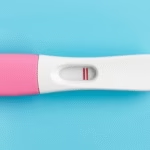Understanding Implantation Bleeding
When a fertilized egg implants itself in the uterus lining, some women may experience a light bleeding known as implantation bleeding. This event usually occurs about 6 to 10 days after fertilization, which may coincide with the expected time of a menstrual period. Implantation bleeding can be a classic early sign of pregnancy, but it can be confused with a light period.
Typically, it lasts for a few hours to a couple of days and is often lighter in color compared to regular menstrual blood. Knowing when implantation occurs can help women understand when to take a pregnancy test for more accurate results. Since the hormonal changes that indicate pregnancy start around this time, it raises the question: How long after implantation bleeding can one take a pregnancy test?
When to Take a Pregnancy Test Post Implantation Bleeding
After experiencing implantation bleeding, many women wonder how long they should wait before taking a pregnancy test. Generally, it is recommended to wait about 3 to 5 days after the bleeding has occurred before testing. This waiting period allows the pregnancy hormone, human chorionic gonadotropin (hCG), to rise to detectable levels in urine.
Many early pregnancy tests are sensitive enough to detect hCG levels as low as 10 mIU/ml, but the accuracy tends to improve if you wait a week after the bleeding. Taking the test too early might result in a negative reading, which could be misleading if you are indeed pregnant. It is essential to consider these factors to get the most accurate results.
Signs You May Be Pregnant After Implantation Bleeding
Along with implantation bleeding, there are several additional signs that may indicate a potential pregnancy. Paying attention to these early symptoms can help women determine if they should take a pregnancy test. Common signs include:
- Missed period
- Nausea or morning sickness
- Breast tenderness or swelling
- Increased urination
- Fatigue
If you experience any combination of these symptoms following implantation bleeding, it is advisable to take a pregnancy test shortly after the recommended waiting period.
What is Human Chorionic Gonadotropin (hCG)?
Human Chorionic Gonadotropin, often abbreviated as hCG, is a hormone produced shortly after a fertilized egg attaches to the uterus lining. hCG is responsible for signaling the body to maintain the pregnancy. It is not typically present in significant amounts in the body unless a woman is pregnant.
The levels of hCG increase rapidly during early pregnancy, which is why many pregnancy tests rely on its detection. They can often be used as early as the day of a missed period, but waiting a few days after implantation bleeding will yield more accurate results. The hormone level can be tested through both urine and blood tests, but urine tests are more popular for home use.
How Implantation Bleeding Differs from Menstrual Bleeding
It is crucial to differentiate implantation bleeding from menstrual bleeding, as they can easily be confused. Implantation bleeding is generally lighter, shorter in duration, and presents with a pinkish or brownish hue rather than bright red. Understanding these differences can help pregnant individuals recognize significant signs of early prenatal development.
Menstrual bleeding typically begins heavier and eases into lighter flow, lasting from 3 to 7 days on average. In contrast, implantation bleeding usually lasts for one to three days, featuring no clots or large amounts of fluid. Recognizing these differences can provide clarity during the early stages of deciding whether or not to take a pregnancy test.
Timing of Pregnancy Tests
Timing plays an essential role when it comes to taking pregnancy tests. Taking a test too early may lead to a false negative if hCG levels are not high enough yet. Health professionals usually recommend waiting until the first day of a missed period, which is generally about a week after implantation bleeding.
Using a first-morning urine sample can provide the best results since it tends to be more concentrated. Additionally, following the instructions on the test packaging closely will ensure the most accurate results possible.
Understanding False Negatives and False Positives
A false negative occurs when a pregnancy test reads negative, even if the person is pregnant. This commonly happens when a test is taken too early, and there is insufficient hCG present in the urine. Conversely, a false positive can occur from certain medications containing hCG or other rare medical conditions.
It’s important to consult a healthcare provider if a false positive is suspected. If a negative result occurs yet pregnancy symptoms are still present, a follow-up test may be advisable after a few days to allow hCG levels to rise further.
Consulting Healthcare Professionals
For anyone experiencing unusual symptoms, pregnant or not, consulting a healthcare professional is always a safe option. They can provide useful advice tailored to your specific situation and offer testing for pregnancy if necessary. Healthcare professionals can also explain the results of a pregnancy test and recommend the best next steps based on your health history and current symptoms.
Periodic check-ups are essential for overall health and can greatly contribute to successful pregnancies. Regular consultations can help expectant mothers stay informed about their health and well-being during this important time.
Final Thoughts
Understanding how long after implantation bleeding to take a pregnancy test can significantly impact results and ensure peace of mind in uncertain times. Waiting about three to five days after bleeding allows hCG levels to rise sufficiently for accurate detection in most home pregnancy tests.
It’s essential to stay informed of the various signs of early pregnancy following implantation bleeding, as recognizing these indications can aid women in deciding whether to take a pregnancy test. Knowing the role of hCG in pregnancy reinforces this understanding and emphasizes why timing matters in testing.
Distinguishing implantation bleeding from a regular menstrual cycle can lead to more informed decisions and engender confidence regarding symptoms. Should doubts persist or if unusual symptoms arise, a visit to a healthcare provider ensures a more thorough understanding of one’s health status and pregnancy options.
Ultimately, knowledge about pregnancy timing, the significance of hCG, distinguishing symptoms, and professional consultation plays a crucial role in navigating early stages of potential pregnancy effectively. This balanced approach leads toward a better understanding of one’s body and supports informed choices regarding reproductive health.
Frequently Asked Questions
- What does implantation bleeding look like?
Implantation bleeding is usually light pink or brownish in color and much lighter than a typical menstrual flow. It lasts for a few hours to a couple of days. - Can I take a pregnancy test right after implantation bleeding?
It is advisable to wait 3 to 5 days after implantation bleeding to take a pregnancy test for the most accurate results. - How do I know if I am experiencing implantation bleeding?
Observe the color, flow, and duration of the bleeding. Implantation bleeding will be lighter and last for a shorter time than a typical period. - Is it possible to have a false negative pregnancy test?
Yes, false negatives can occur if the test is taken too early. Waiting a few days after a missed period is recommended for accurate results. - Should I consult a doctor after a positive pregnancy test?
Yes, consulting a healthcare provider after confirming a positive result is crucial for proper guidance and prenatal care.
Further Reading
What Type of Psychotherapy Is Best for Anxiety?







